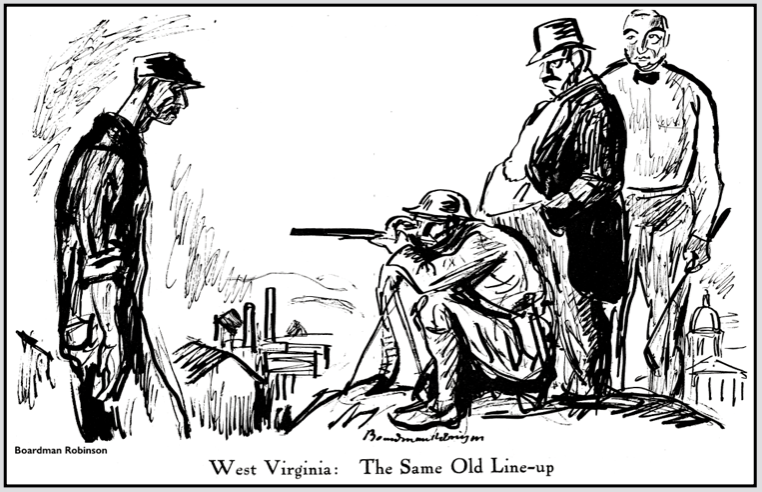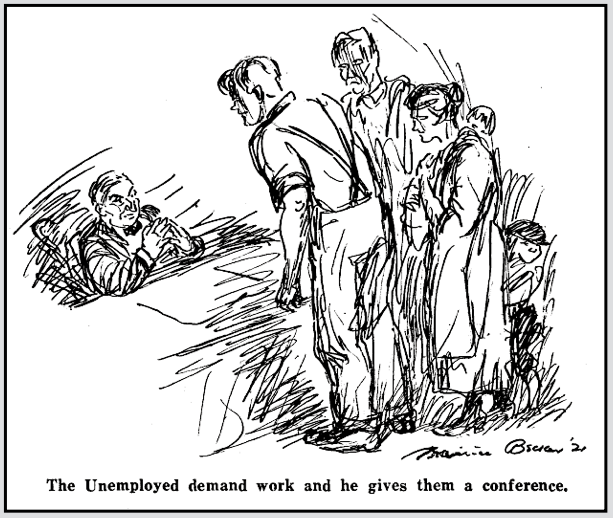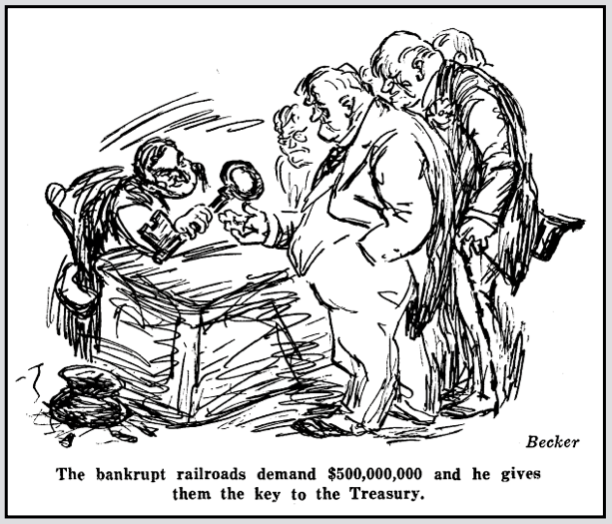 —————
—————
Hellraisers Journal – Wednesday October 5, 1921
Art Shields Reports from West Virginia on Battle of Logan County
From The Liberator of October 1921:
The Battle of Logan County
By Art Shields
———-[Part I of II.]
“THESE are our hills and we love ’em. We had to fight for them long ago, against the bears and the panthers and the wolves and the rattlesnakes, and now I reckon Don Chafin’s thugs ain’t a-goin’ to scare us out.“
A sturdy old mountaineer of more than three score and ten voiced these sentiments as we stood together on one of the loftiest peaks of Blair Mountain and filled our eyes with the surrounding magnificence of giant shaded valleys and mighty ridges, tossed in forested glory against the sky. It was a garden of towering wonder that blinded my eyes for the moment to the shallow trench at my feet, where thousands of empty shells were ugly reminders that Don Chafin’s machine gunners and automatic rifle men had been nesting there a few days before.
We were tramping over the southern end of the fifteen miles of wilderness where twenty-thousand men had been contesting the right of the thug system to exist in the mining fields of West Virginia. The battle had lasted through an entire week, during the closing days in August and the first ones of September, and it ended with the gunmen giving way along more than half their line after sustaining losses second only to those of the Paint and Cabin Creek campaigns. Two thousand federal troops came none too soon to prevent the miners from sweeping on through the mountain barriers, through the terror-haunted scab lands of Logan county, and on to the protection of their fellow union men under the heel of a bloody state martial law in the Mingo fields beyond.
Ten thousand labor volunteers with high powered rifles leaving work and wives and rushing to the defense of their fellow union men nearly seventy miles away from the scene of mobilization! For an injury to one is an injury to all among the union miners of West Virginia. By their organized solidarity they have pulled themselves out of an industrial tophet that passes description. Mother Jones told me of miners working fourteen hours in the olden days in the state, and my veteran mountaineer friend smiled at this conservative statement, saying it was nearer eighteen. But step by step conditions have been lifted half way out of the mire. Desperate fighting has marked the unionization of each succeeding field of the high grade industrial coal which makes the state so desirable in the eyes of the great steel interests. But slowly and surely the organization has gained ground til today the operators are keeping Logan, McDowell, Mercer and Wyoming counties non-union only by the aid of several thousand deputized thugs, most of them drawn from the Baldwin-Feltz agency. In these counties murders are so common that the formalities of the coroner are seldom attended to.
A year ago the United Mine Workers organized the men of Mingo County, which produces some of the beast coking coal in this country. The operators locked the union men out and dispossessed their families from company houses. A strike was the counter-attack of the union and in the rough and tumble fighting which took place hereabouts between the two sides the thugs fared badly, especially in the battle of Matewan which was graphically described for the Liberator readers a year ago. So the operators called in the state constabulary and state militia and since then, the Mingo miners, still standing by their strike that has crippled production nearly two-thirds, have been living under a murder regime that is excelled only in number of casualties by Logan County itself.
Miners have been shot down and tent colonies have been raided again and again. The United Mine Workers have kept the locked-out miners alive with weekly payments taken from dues and special assessments, but the rank-and-file of the West Virginia miners have been demanding more vigorous action than that given by their purses. “Nothing will do but that we go down there and set that place to rights ourselves,” they said among each other.
But ten thousand armed miners-the number needed to overcome resistance on the way, are not easily pulled away from work and wife for a military campaign. It takes something tremendously dramatic and horror-raising to get such a force moving. The attacks on the Lick Creek Tent Colony and the steadily increasing murders did not have quite the necessary dynamic effect. Had the union officially called for volunteers, or had it sanctioned such a move, the miners might have gone flying; but something terrific that would shock all their working-class love and dignity had to happen before they would start on their own initiative.
It happened on July 31. I will let Mrs. Sid Hatfield tell the story as she told it to me in Matewan, in the little apartment over the jewelry store, where she has been living since Sid was murdered.he began
[She began:]
Sid never knew what killed him. Those Baldwin thugs were all hiding up there in wait for him on the top of the court house steps. I had begged Sid to take his guns along, but he said he wouldn’t need them, and it didn’t look nice to carry guns into the court house.
They indicted Sid, you know, for shooting at Mohawk in McDowell County. Sid never knew anything about it. He hadn’t been away from Mingo County or even from Matewan since we were married fifteen months ago, except that time he went to Washington to testify before the Senate Committee. It was just a trick to get him away from his friends and kill him.
I guessed they were fixing to kill him, but the high sheriff of McDowell County, that’s Bill Hatfield, a distant kin of Sid’s, said he’d give him protection if he came on to the other county to answer the indictment. I was still nervous about it, but Sid went, anyhow.
Ed Chambers and his wife Sallie came along with us. We went down on the night train, but the thugs knew all about it, for that fellow Lively got on twenty-five miles this side of Welch, the county seat of McDowell County, where we were going. That is the fellow, you know, that testified against Sid at the other trial. And next morning at breakfast there he was again, sitting next to us in the Busy Bee restaurant in Welch.
Mr. Van Fleet, our lawyer, told Sid to be careful about going to the courthouse, for he didn’t like the idea of this fellow following us, but Sid just laughed. He wouldn’t take his guns but left them in the suit case.
That Welch court house is up two flights of steps. Everything looked all right as we started. Ed Chambers and Sallie in front. Sid had one foot on the second flight and was waving a hello to one of the other defendants in his case, who was standing near by, when a bunch of men stepped out of the doorway and began firing. Sid wheeled around and tumbled, and so did Ed. I ran up the steps, passed eight men shooting from the hip-like this. I don’t know how they missed me. I ran inside calling for the sheriff, but he wasn’t there. Then they told me that Sid wasn’t killed. When I got out Sid had been taken away.
Mrs. Hatfield was devoted to Sid, but she is a mountain girl and knows the uselessness of bewailing the sudden death of her man, so she told the story quietly and without tears. Another witness took up the narrative where she left off and told how Lively had pumped his revolver into the body of Chambers, while most of the others concentrated on Hatfield. The first two shots hit Sid in the arm and a second later a gunman put his revolver to Hatfield’s back and shot three times.
So died these lion-hearted, laughing young men, the salt of the earth. And they died, not fighting as they would have chosen, but murdered in cold blood by sneering deputies, right on the threshold of the mocking temple of the law, and the murderers were allowed to go at large under bail. “Well, I’m glad that’s over now,” a high official of McDowell County is reported to have said that same day. Two practical opponents of the thug system were gone and Tom Feltz stood avenged of the deaths of his brothers Albert and Lee, who fell in the Matewan battle on May, 1920. Shortly after, this same gentleman complacently registered as a candidate for congress on the Republican ticket in Galax in Old Virginia.
Success seemed to be smiling on the dual vested interests of coal operators and gunmen, and the prospects of wiping out all semblance of unionism in the rich coking coal fields of Mingo County, appeared better than ever. And if in Mingo, why not all over West Virginia?
The funeral of Sid Hatfield, held a few days later from Matewan to the old Hatfield cemetery across the Tug River in Kentucky, might have given them pause. They might have noted the delegations that came from far and near while mining camps shut down for the day. They might have seen six hundred railroad shopmen coming from Huntington with an immense bower of flowers sent by their two thousand railroad workers there, who had closed down the shops for the day in memory of the passing of their brave fighter.
“It will blow over,” was the comforting sentiment of the operators when their stools brought them word of the indignation flying like a fiery cross through the central and northern counties of the state. “It will blow over as these things have been blowing over for years,” they reassured themselves.
But the workers were shaking with fury that was boiling and not blowing over.
—————
~~~~~~~~~~~~~~~~~~~~
SOURCES & IMAGES
Quote EVD Wlg WV Oct 24, Wlg Dly Int p2, Oct 25, 1900
https://chroniclingamerica.loc.gov/lccn/sn84026844/1900-10-25/ed-1/seq-2/
The Liberator
(New York, New York)
-Oct 1921, page 16
https://www.marxists.org/history/usa/culture/pubs/liberator/1921/10/v04n10-w43-oct-1921-liberator.pdf
See also:
-by Art Shields:
My Shaping Up Years
https://www.goodreads.com/book/show/944242.My_Shaping_Up_Years
On the Battle Lines, 1919-1939
https://www.goodreads.com/book/show/7285788-on-the-battle-lines
Boardman Robinson
https://en.wikipedia.org/wiki/Boardman_Robinson
Maurice Becker
https://en.wikipedia.org/wiki/Maurice_Becker
Tag: Battle of Blair Mountain 1921
https://weneverforget.org/tag/battle-of-blair-mountain-1921/
Tag: Mingo County Coal Miners Strike of 1920-1922
https://weneverforget.org/tag/mingo-county-coal-miners-strike-of-1920-1922/
Tag: Sid Hatfield
https://weneverforget.org/tag/sid-hatfield/
~~~~~~~~~~~~~~~~~~~~~~~~~~~~~~~~~~~~~~~~
“Sid” – Alan Cathead Johnston, Jessi Shumate, Nathan Lawson (banjo)
Lyrics by David Grubb and Johnston



